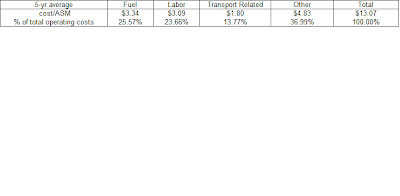Recently, the media have been buzzing about new found discipline among domestic carriers in introducing new capacity. "Capacity discipline,” as the experts call it. If indeed this is the case, the airline industry must be commended for finally putting its business model in order. Something it has been striving to do since de-regulation but has been unable despite downturns and bankruptcies.
On the face of it, claims of capacity discipline seem well-founded. Domestic capacity for the Jan – Jul period, as measured by available seat miles (ASM), is almost flat - down to 390 billion from 391 billion – a drop of 0.25%. This is after dropping around 9% from 2008 to 2009 for the same time period (Jan - Jul). In all, domestic capacity for Jan – Jul 2010 has fallen 9.3% compared to the same period in 2008. Experts suggest that this capacity discipline would be the foundation for a new and unprecedented era of airline profitability. The current consolidation, with a series of mergers and acquisitions, lends further credence to the argument that carriers would be more careful in extending capacity in the future.
However, the phenomenon of capacity discipline raises two interesting questions. First, are all carriers equally disciplined. And second, is this discipline more the result of a weak, uncertain economy than some newly found wisdom among airline leaders.
The first question is relatively easily answered. A cursory comparison of ASMs from Jan-Jul YoY shows that most major carriers have kept capacity flat. However, “smaller” and predominantly "low-cost" carriers such as Alaska, Jet Blue and Airtran have increased capacity. Other large carriers, in fact the largest and the third largest – Delta-NW and American, have kept capacity fairly flat. Consequently, the brunt of capacity discipline has been borne by Southwest and legacy carriers such as United, US Airways, and Continental.
As evident from the table, while Southwest and the four network carriers – American, United, Continental and US Airways reduced domestic capacity in Jan – Jul '10 by around 4.0 billion ASMs compared to Jan – Jul '09, the industry, shed only 982 million ASMs over the same period . In fact, Alaska, Airtran and Jetblue added almost 30% of the capacity shed by the large 5 carriers mentioned earlier.
Though too early to conclude much, carriers such as Jetblue and Airtran have traditionally been considered aggressive, well-run, better managed and more efficient (reflected in their relatively high valuations – Jetblue has a market cap of $2.01B on quarterly revenues of $939MM; Airtran market cap: $1.01B, revenue: $700 MM; Alaska market cap: $1.8B revenue $976MM). Would these carriers, especially after the proposed merger between Airtran and Southwest, sense reluctance on the part of the majors to add capacity and continue being aggressive and what would be the likely competitive response. How long would the larger carriers maintain discipline as their competitors add capacity will certainly be interesting to watch. Indeed, in an era of record load factors and yield, it is going to be hard for carriers to resist adding capacity.
Though, one needs to understand that just as real estate is all about location location location, airline capacity is all about routes and yield. So a decrease in capacity by the majors could, in fact, bode well as they give up less lucrative, less strategic routes. However, to extend the same rationale to conclude that carriers would be disciplined while adding capacity on higher-paying routes doesn't quite seem consistent with the industry's past behavior. A recent artilce in BusinessWeek titled “ About the Airline Capacity Discipline...” by Justin Bachman on October 22, 2010 also raises the same concerns http://www.businessweek.com/lifestyle/travelers_check/archives/2010/10/about_that_airline_capacity_discipline.html. But then, all of us related to the industry hope this time it's different.







